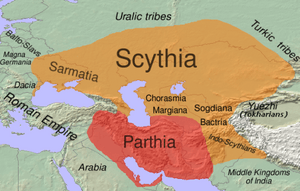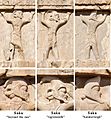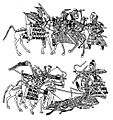Saka facts for kids
 Approximate extent of East Iranian languages the 1st century BCE is shown in orange. |
|
Quick facts for kids Total population |
|
|---|---|
| (Unknown) | |
| Regions with significant populations | |
| Eastern Europe Central Asia Northern India |
|
| Languages | |
| Scythian language | |
| Religion | |
| Animism | |
| Related ethnic groups | |
The Sakas were a group of Iranian people. They were nomadic, meaning they moved from place to place. These tribes lived across the vast plains of Eurasia, from Eastern Europe all the way to China. They were around from ancient times, during the Old Persian Period, until the Middle Persian Period. Later, other groups who spoke Turkic languages moved into their lands.
The ancient Greeks had a different name for the Sakas. They called them the Scythians.
Contents
Who Were the Sakas?
The Sakas were skilled horse riders and warriors. They were part of a larger group of people known as the Scythians. These groups shared similar ways of life and cultures. They were known for their strong connection to horses. Horses were important for travel, hunting, and fighting.
Where Did the Sakas Live?
The Sakas lived in a huge area called the Eurasian Steppe. This is a vast grassland that stretches across continents. Their territory reached from the Black Sea in the west to parts of China in the east. They also lived in Central Asia and even northern India. Their nomadic lifestyle meant they often moved with their herds of animals.
Saka Culture and Daily Life
Saka culture was rich and interesting. They were known for their unique art, often featuring animals. This art is sometimes called "animal style." They created beautiful objects from gold, bronze, and felt. These items often showed powerful animals like stags, eagles, and big cats.
Their Nomadic Lifestyle
Life for the Sakas was all about movement. They lived in portable homes, likely tents, that could be easily packed up. They moved with the seasons to find fresh pastures for their livestock. Their main animals were horses, sheep, and cattle. This way of life made them very adaptable and tough.
Saka Language
The Sakas spoke a language called Khotanese Saka. This language belongs to the Eastern Iranian languages family. It is part of the larger Indo-European languages group. We know about their language from ancient documents. Some of these documents were found in places like Khotan. They show us how the Sakas wrote and communicated.
Sakas and Other Empires
The Sakas often interacted with powerful empires. They sometimes traded with these empires. Other times, they fought against them. The Achaemenid Empire (ancient Persia) knew about different Saka groups. They even described them in their records. Some Sakas were known for their pointed hats. Others were called "Hauma drinkers."
Indo-Scythians
A group of Sakas moved into northern India. They became known as the Indo-Scythians. They ruled parts of India for a time. They even minted their own coins. These coins often showed images of their kings and symbols. This shows how far their influence spread.
The Pazyryk Culture
The Pazyryk culture is another group closely related to the Sakas and Scythians. They lived in the Altai Mountains. Archaeologists have found amazing things in their burial sites. These include well-preserved bodies, clothing, and horse gear. These findings give us a great look into their daily lives and beliefs. They show how important horses were to them.
Images for kids
-
For the Achaemenids, there were three types of Sakas: the Sakā tayai paradraya ("beyond the sea", presumably between the Greeks and the Thracians on the Western side of the Black Sea), the Sakā tigraxaudā ("with pointed caps"), the Sakā haumavargā ("Hauma drinkers", furthest East). Soldiers of the Achaemenid army, Xerxes I tomb detail, circa 480 BC.
-
A document from Khotan written in Khotanese Saka, part of the Eastern Iranian branch of the Indo-European languages, listing the animals of the Chinese zodiac in the cycle of predictions for people born in that year; ink on paper, early 9th century
-
Scythia and the Parthian Empire in about 170 BC (before the Yuezhi invaded Bactria).
-
Silver coin of the Indo-Scythian King Azes II (ruled c. 35–12 BC). Note the royal tamga on the coin.
See also
 In Spanish: Sacas (tribu) para niños
In Spanish: Sacas (tribu) para niños











